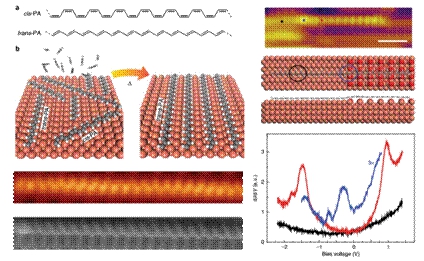On September 2, 2019, Nature Chemistry published online a paper “On-surface Synthesis and Characterization of Individual Polyacetylene Chains”, reporting a significant progress made by Professor XU Wei's research team of Tongji University and Professor Roman Fasel's research group of Swiss Federal Laboratories for Materials Science and Technology on the accurate preparation, characterization and electronic property measurement of polyacetylene chains at the surface atomic level.
Polyacetylene is a one-dimensional chain structure formed by sp2 hybridized carbon atoms. It is the first conductive polymer to be studied. It has a relatively simple chemical structure and has two basic configurations, cis and trans, depending on the arrangement of carbon atoms. Due to its simple chemical structure and abundant electronic properties, polyacetylene has become an ideal system for studying the charge transport properties of one-dimensional conductive polymers. Three scientists shared the Nobel Prize for chemistry in 2000 for "discovering and developing conductive polymers" through their research on polyacetylene. In addition, the SSH model developed based on the research of polyacetylene also plays a key role in explaining the electronics and topological properties of one-dimensional materials. However, the in-depth understanding of the intrinsic electronic characteristics of polyacetylene is still limited by the accurate preparation and characterization of materials at atomic level.
XU’s research team and Fasel’s research group prepared cis and trans polyacetylene chains on copper (110) surface in ultra-high vacuum environment using acetylene as precursor molecules by surface chemical methods. Their chemical structures were characterized by scanning tunneling microscopy (STM) and atomic force microscopy (AFM) high resolution imaging methods. Experiments show that due to the strong interaction between polyacetylene and copper substrate, polyacetylene is doped with electrons and exhibits metallic properties. In addition, by forming a single layer of copper oxide at the copper surface and the polyacetylene interface, the interaction between the copper surface and the polyacetylene is effectively blocked, and the polyacetylene adsorbed on the copper oxide layer exhibits intrinsic semiconductivity (~ 2.4 eV energy band gap). This study provides the possibility to further explore the intrinsic physical properties of polyacetylene such as soliton state in real space.

About the paper:
Full-text paper“On-surface synthesis and characterization of individual polyacetylene chains” is available at https://www.nature.com/articles/s41557-019-0316-8.
Source (in Chinese):https://news.tongji.edu.cn/info/1003/70883.htm